Artificial intelligence (ai) and its impact to business
•Download as PPTX, PDF•
1 like•4,161 views
AI continues to expand into different areas like healthcare, agriculture, scientific research and auditing. AI is still only touching the surface when it comes to its application, especially if AI can work with time-series data.
1 of 13
Downloaded 73 times
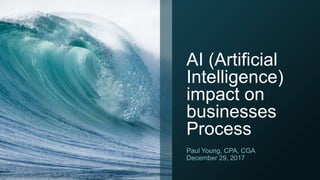

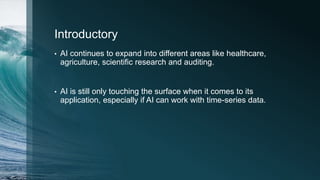
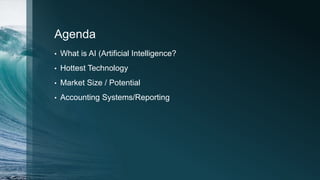
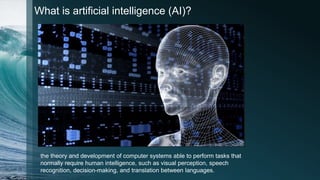
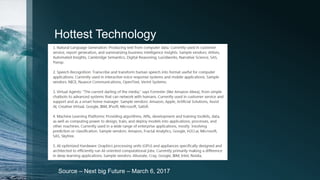
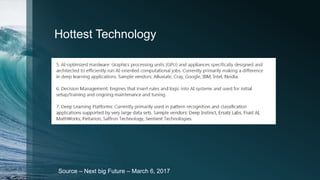

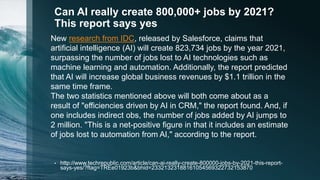
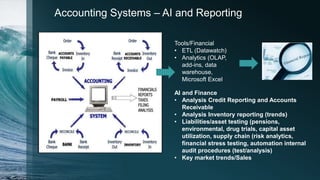
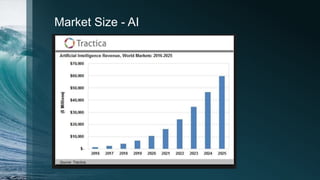
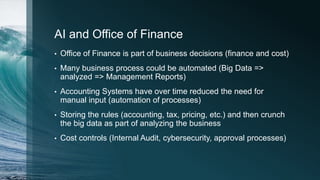
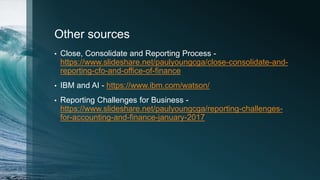
Recommended
AI in Marketing



AI in Marketingvganti This is a deck on the state of Artificial Intelligence applications in Marketing. It covers an overview of the AI types and algorithms being used for Marketing use cases, a brief of the near-term future of AI in marketing, and covers some Marketing startups focusing on AI technologies.
Artificial Intelligence for Business



Artificial Intelligence for BusinessNicola Mattina These deck contains an overview of what is commercially available in terms of Artificial Intelligence for business applications. Be aware: it was created on April 2017 and this is a very fast moving industry....
Artificial Intelligence and Machine Learning

Artificial Intelligence and Machine LearningMykola Dobrochynskyy The document discusses artificial intelligence and provides an overview of key topics including:
- A brief history of AI beginning with the 1956 Dartmouth conference where the field was first proposed.
- Types of AI such as artificial weak intelligence, artificial hybrid intelligence, and artificial strong intelligence.
- Applications of AI such as computer vision, machine translation, and robotics.
- Progress in deep learning including speech recognition, computer vision, and machine translation.
- Demos of AI services including a cognitive race between AWS and Azure and using an AWS bot with Lex.
Artificial intelligence in business

Artificial intelligence in businessDr. Hosam AbouElDahab This document discusses artificial intelligence and its commercial applications. It defines AI as using computer science, biology, psychology and other fields to develop computers that can think and act intelligently like humans. It then discusses several commercial applications of AI including decision support systems, information retrieval systems, virtual reality, and robotics. The document also provides overviews of expert systems, which use knowledge bases to solve problems like human experts, and fuzzy logic systems, which allow for approximate reasoning similar to human reasoning.
Artificial Intelligence Applications in Business 

Artificial Intelligence Applications in Business RachiPandya The document discusses various applications of artificial intelligence in business. It describes key areas of AI including cognitive science, robotics, natural language processing, expert systems, fuzzy logic, neural networks, biometrics, and virtual reality. For each area, it provides examples of real-world business applications such as using expert systems for employee performance evaluation, applying fuzzy logic to personnel evaluation, training employees with virtual reality, and implementing chatbots using natural language processing. The conclusion states that AI adoption will help businesses stay competitive and that its applications across organizations continue to grow widespread.
AI Solutions in Manufacturing

AI Solutions in ManufacturingSri Ambati H2O.ai provides open source machine learning platforms and enterprise AI solutions that help companies implement artificial intelligence. It offers tools for data scientists to build models using Python and R and also provides support services to help customers successfully deploy models in production. H2O.ai aims to democratize AI and help companies become AI-driven by leveraging its experts, community knowledge, and world-class technology.
Artificial intelligence in industry

Artificial intelligence in industryDipanjan Mitra The document discusses using artificial intelligence and natural language processing techniques for various industry applications, including using NLP for customer service by analyzing customer interactions, monitoring brand reputation by scanning online mentions, targeting ads by understanding users' interests from their online behaviors and documents, and gaining market intelligence by analyzing information about competitors. It provides examples of how NLP tasks like speech recognition, question answering, sentiment analysis and coreference resolution can be applied to these industry use cases.
Artificial intelligence in business

Artificial intelligence in businessNisha Choudhary This document discusses artificial intelligence (AI) and its applications in business. It describes AI as the intelligence of machines and the branch of computer science that aims to create machine intelligence through techniques like neural networks, expert systems, and natural language processing. The document outlines how AI is used in various business functions like finance, marketing, human resources, manufacturing, and more to tackle complex problems, analyze data, optimize processes, and increase productivity. It also provides examples of specific AI applications in credit screening, forecasting, customer relationship management, and manufacturing scheduling.
More Related Content
What's hot (20)
Artificial Intelligence In The Workplace: How AI Is Transforming Your Employe...

Artificial Intelligence In The Workplace: How AI Is Transforming Your Employe...Bernard Marr Artificial Intelligence (AI) is augmenting our workplaces and transforming the employee experience. In this article, we look at what this means in practice and explore practical examples, benefits, and drawbacks.
AI in Business: Opportunities & Challenges

AI in Business: Opportunities & ChallengesDr. Tathagat Varma In this talk, I discuss how AI impacts the business, what are the challenges and what are the opportunities.
Artificial intelligence - An Overview

Artificial intelligence - An OverviewGiri Dharan Artificial intelligence is the science and engineering of making intelligent machines, especially intelligent computer programs. There are four main schools of thought in AI: thinking humanly, thinking rationally, acting humanly, and acting rationally. Popular techniques used in AI include machine learning, deep learning, and natural language processing. The document then discusses the growth of AI and its applications in various domains like healthcare, law, education, and more. It also lists the top companies leading the development of AI like DeepMind, Google, Facebook, Microsoft, and others. Finally, it provides perspectives on the future impact and adoption of AI.
Artificial intelligence

Artificial intelligenceGuduru Lakshmi Kiranmai Title: Incredible developments in Artificial intelligence which was the future scenario.
Here I discussed the with the major backbones of AI (Machine learning, Neural networks) types Machine learning and type of Artificial intelligence and with some real-time examples of AI and ML & Benefits and Future of AI with some pros and Cons of Artificial Intelligence.
Artificial intelligence

Artificial intelligenceUmasree Raghunath Artificial intelligence (AI) is the field of computer science that develops machines or software with human-like intelligence. AI can perform tasks like humans or even better than humans through activities like speech recognition, decision making, and translation. There are two main categories of AI: narrow AI, which is dedicated to a specific task, and strong/general AI, which does not currently exist but is being researched to allow machines to think like humans through their own intelligence and self-awareness. AI has many applications across industries like healthcare, transportation, education, and more. The evolution of AI began in the 1940s and important milestones include the invention of the Turing test in 1950, the development of machine learning in the 1950
Ai in Digital Marketing

Ai in Digital MarketingDmitri Zotov This document discusses how artificial intelligence is being applied in digital marketing. It outlines several ways AI can be used, including personalizing the user experience through smart content curation, chatbots, and predictive analytics. It also discusses how AI can help with lead generation through ad click prediction, ad personalization, and programmatic media buying. The document emphasizes that AI is already widely used in business and that companies should leverage their data through personalization rather than averaging to not miss opportunities with AI.
AI and Future Jobs

AI and Future JobsDavid Asirvatham The document summarizes a presentation given by Prof. Dr. David Asirvatham on AI and future jobs. The presentation discusses how AI will impact various jobs and industries in the coming years and decades. It notes that many existing jobs will be automated or replaced by machines, but that AI will also create new types of jobs and work. The presentation emphasizes that acquiring new technological skills will be important for workers to adapt and ensure they are not left behind as AI disruption occurs. It concludes that AI will significantly change how people live and work, with humans needing to work together with machines.
Artificial intelligence my ppt by hemant sankhla

Artificial intelligence my ppt by hemant sankhlaHemant Sankhla This document discusses a PowerPoint presentation (PPT) that was created in Microsoft Office 13. It notes that some transitions and effects may not display properly since the PPT was created in an older version. It also mentions that some fonts used in the PPT may not display if the viewer does not have those fonts, but the fonts can be changed as needed.
Similar to Artificial intelligence (ai) and its impact to business (20)
How To Find Needles In Haystacks

How To Find Needles In HaystacksMaruthi Nataraj K The document discusses data analytics and the growing analytics industry. It defines data analytics as the process of inspecting, cleaning, transforming, and analyzing raw data to extract useful information. The amount of data generated worldwide has increased dramatically in recent years. The analytics industry includes captive, pure-play, and third-party service providers. Indian companies are getting into analytics due to available talent, lower costs than Western companies, and the ability to better understand local data and make improved decisions. The document outlines challenges and examples of analytics applications in various industries.
Unit-5.docx

Unit-5.docxLAKSHMI V Emerging Trends in Accounting 08 Digital Transformation of Accounting-Big Data Analytics in Accounting-Cloud Computing in accounting- - Green Accounting-Human Resource Accounting, Inflation Accounting, Database Accounting
Big data destruction of bus. models

Big data destruction of bus. modelsEdgar Revilla Lavado Big data offers opportunities for companies to gain competitive advantages through improved customer intimacy, product innovation, and operations. The document discusses how various companies are leveraging big data across industries. It notes that 45% of companies have implemented big data initiatives in the past two years and over 90% of Fortune 500 companies will have initiatives underway soon. Harnessing big data's potential requires understanding where it can create value within a company and having the right organizational structure, technology investments, and plan to capture those benefits.
TLNBusinessAnalytics_researchPoster_Final

TLNBusinessAnalytics_researchPoster_FinalYi Qi This document analyzes gaps between business analytics skills needed in industry versus those taught in academic programs. Key findings include:
1) Academic programs emphasize statistical techniques but industries need skills like communication, experience, and skills relevant to specific fields like IT, insurance, and marketing.
2) Text mining of academic papers found a focus on techniques, applications, and theories of big data while industry articles focused more on organizational innovations and improvements from big data.
3) Analyses of literature on topics like operations, accounting, and marketing revealed both similarities and differences in focus between academic and industry discussions.
Introduction part1

Introduction part1Maj Gonzales This document provides an introduction to strategic management of information systems. It discusses that IS must be managed as a critical business resource and enable changes to how people work together. IS are involved in almost every aspect of business and can enable new opportunities/strategies or be used to address challenges from competitors. It also views IT as a major business resource that requires wise management and explains how IS decisions directly impact business profits. Failure to align IS, business, and organizational strategies can lead to misalignment or IS that do not support goals. Finally, it discusses assumptions about management, business, and information systems as well as the economics of information versus things.
Big data

Big dataISME College Big data offers companies a big advantage if they can harness enormous data sets that were previously impossible to process. The document discusses how big data is transforming business models through creative destruction, as more data is created every day from various sources. It provides examples of how companies in various industries like retail, banking, and manufacturing are using big data for customer intimacy, product innovation, and improving operations. Specifically, companies are able to better customize products and services, improve supply chain management, and gain real-time insights from vast amounts of structured and unstructured data.
Business Analytics In India

Business Analytics In Indiatushar kumar The document discusses business intelligence and analytics in India, including trends, challenges, and growth. It notes that while the industry in India is growing, it faces challenges like a lack of relevant data, shortage of skilled workers, fragmented market, and need for more domain-specific education. However, trends like a growing focus on industries like retail and banking, and increased use of mobile business intelligence, are supporting the growth of the industry. The industry is expected to reach revenues of $140 million in India by 2014.
Information-Systems-and-Technology.pptx

Information-Systems-and-Technology.pptxAhimsaBhardwaj Information systems are combinations of hardware, software, and networks that organizations use to collect, create, and distribute useful data. They help process and manage data, monitor performance, and support decision making. Information systems are central to virtually every organization and provide users with resources like Wi-Fi networks, database search services, and printers. They consist of hardware, software, data, knowledge, and telecommunications components. Data analytics uses specialized software to explore large volumes of data and provide insights to help organizations grow customer bases, improve efficiency, and detect fraud. Common types of information systems include transaction processing, office automation, decision support, and executive information systems.
